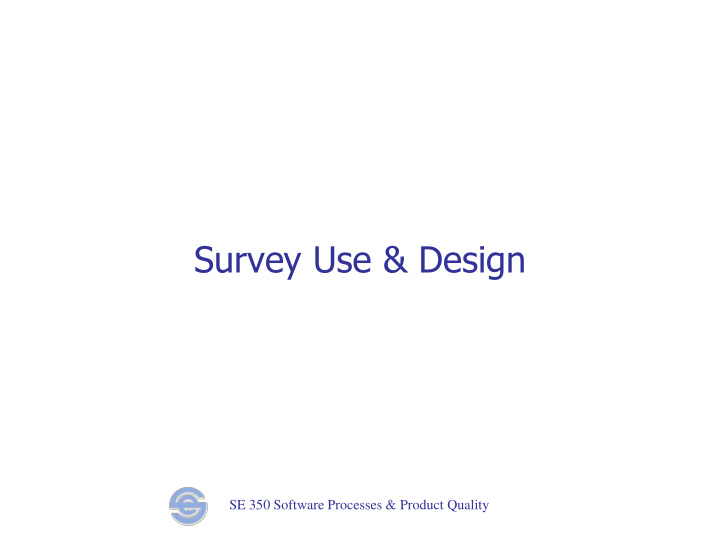



Survey Use & Design SE 350 Software Processes & Product Quality
Customer Satisfaction Surveys Random sampling for large customer base. May “stratify”: group according to criteria. Formulae for sample size to get statistical validity. Exhaustive sampling for small customer base. Some survey data collection techniques: Face-to-face interviews: can provide clarifications Telephone interviews: cheaper, less effective Questionnaires: low response rates, danger of “self - selection” Too many surveys can be irritating. Timing of survey affects responses! SE 350 Software Processes & Product Quality
The Steps in a Survey Project Establish the goals of the project - What do you want to learn? Determine your sample - Whom will you interview? Choose interviewing methodology - How will you interview? Create your questionnaire - What will you ask? Pre-test the questionnaire, if practical - Test the questions. Conduct interviews and enter data - Ask the questions. Analyze the data - Produce the reports . [Creative Research Systems] SE 350 Software Processes & Product Quality
Survey Objectives Important to be clear about survey objectives: “Formative”: Purpose is to serve as a guide for improvement. “Summative”: Purpose is to evaluate the outcome. Formative surveys need to pinpoint reasons behind dissatisfaction. Impacts question choices. Need to relate questions & responses to actions. If the response is X, what will be done? Need more open-ended questions. Summative surveys need considerable attention to minimizing bias and maximizing validity. Specific objectives: What aspects do we want to know about? SE 350 Software Processes & Product Quality
Survey Design The design of the survey can heavily influence the results Wording of the question may introduce biases Set of response choices provided may push towards some responses, limit the possible answers, or confuse the responder Order of questions may “habituate” responders or set contexts that determine responses Length of survey may determine level of attention paid, and whether the survey gets responded to (KISS) Good resource on survey design: http://www.surveysystem.com/sdesign.htm Specifically about designing web surveys: http://lap.umd.edu/survey_design/guidelines.html SE 350 Software Processes & Product Quality
Interviewing Methods Personal Interviews Telephone Surveys Mail Surveys Computer Direct Interviews Email Surveys Web Surveys Scanning Questionnaires [Creative Research Systems] SE 350 Software Processes & Product Quality
Survey Analysis Indicate sample size. May cluster responses for ease of presentation. E.g. Combining “satisfied” and “very satisfied” may simplify picture. Present information in ways that highlight significant results: Does “neutral” get clubbed with “satisfied” or “dissatisfied”? Percent dissatisfied is useful if percent satisfied is high. Difference between 95% satisfied and 98% satisfied is significant. Histogram of satisfaction on different quality attributes. But some attributes may be much more critical! Use colors to highlight small-but- significant items, such as “did not use” Summarize write-in comments. Cross-check with personal feedback! SE 350 Software Processes & Product Quality
Bias Examples Source: http://www.surveysystem.com/sdesign.htm SE 350 Software Processes & Product Quality
Metrics Trends in customer satisfaction. Individual elements may be more informative than just satisfaction data. Comparisons across products. Especially if same survey questions used. Volume of customer complaints. Market share trends. Measures value proposition + perception, not just satisfaction Actual % of repurchase, % of customers buying based on recommendations (Common survey questions: Overall satisfaction, Willingness to repurchase, Willingness to recommend) SE 350 Software Processes & Product Quality
Limitations Customer satisfaction is not the ultimate goal. Need to focus also on value proposition, perceptions. Results are very dependent on the questions asked and the timing Using the same instrument consistently helps. Tradeoff between marketing / perception management and not setting expectations too high. Surveys have many built-in limitations. For example, customers telling you what you want to hear/ using it as a forum to vent. Balance with other ways to gauge satisfaction. Customer satisfaction survey results are often a marketing tool. Creates strong incentive to try and manipulate for favorable results! Overall satisfaction has many factors: very crude indicator. Good satisfaction numbers can paper over many real problems. SE 350 Software Processes & Product Quality
Summary Customer satisfaction is the ultimate measure of quality. Surveys are the most common way to measure satisfaction. Survey design is complex and critical. Satisfaction depends on product quality, support, but also expectation setting. Customer satisfaction surveys are most commonly formative. Identify opportunities for improvement. SE 350 Software Processes & Product Quality
Recommend
More recommend